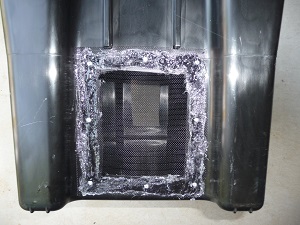Crickets Escaping From Your Cricket Farm are Common and are Easily Prevented.
Below are the most common escape pathways and tips to reduce them:
• Look for any gaps or cracks in the container and seal them with silicon. The most common location crickets get out, is the edges of ventilation screening. To prevent this, make sure the silicon makes contact all the way through the screen. This is achieved by placing silicon on the underside and top of the screen and push it through using a spatula.

• Crickets can chew through fiberglass screening (window screening). Once they eat through, thousands of crickets can escape. Replace fiberglass screening with aluminum screening, and choose the right gauge (see below section for more detail).
• As a pinhead has a width of only 0.019 inches or less (0.5mm or less) they can get through many common fly screens which typically have an aperture of 0.079 inches (2mm) or more. Click here for a simple test to work out where your crickets and pinheads are getting out.
• When you open the lid, tap it first to startle the ones on the top. They generally will scatter to the bottom. Then open the lid slowly.
• Crickets are good jumpers and easily jump out of a container when you open the lid for feeding or maintenance. Try to buy containers with high sides at least 3.9-5.9 inch (10-15cm) higher than the cartons.
• Pinheads are encouraged to forage for food when they struggle to find sufficient food or water. Click here for more details on how to keep these things plentiful within your cricket farm with automated food and water dispensers and they are less likely to wander.
• Incorrect lid types are a common problem for not only crickets escaping but are also a way for pests such as vinegar flies to get in. We recommend using a lid which has edges on it that are “U” shaped. This lid type is commonly used by restaurants to prevent the entry of cockroaches into their food.
• Crickets can climb many surfaces, however adults have difficulty climbing smooth plastic and glass surfaces. When picking a container, choose one with smooth plastics that are hard to climb. If however they are able to climb a surface, you can prevent this by placing clear strapping tape along the top of the container.
• Even a smooth plastic can be made climbable when it gets covered in dust and grime, so keep the top of the container clean at all times.
• If pinheads are small enough to get out, common pest such as vinegar flies are also able to get in. For tips on choosing the right screen aperture and how to avoid pests damaging your cricket farm, see below.
Tips on Getting the Right Screening for Ventilation Ports
If pinheads are getting through your screening, you can replace it with midge screen with has a gauge of 0.059-0.019 or less (1.5-0.5mm). The problem however is that this screening is usually fiberglass which can be eaten by crickets. At WildlifeHub we found this out first hand when not only were pinheads getting out, but common pests such as vinegar flies were also getting in eating all the eggs of the crickets. This is why we developed a unique double screen system that has the best of both worlds: prevents crickets from eating the screen; cricket escapes; and the entry of small pests such as vinegar flies.
Click here to learn more about how to build an efficient cricket enclosure and to breed crickets with less effort.
